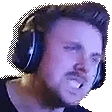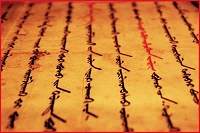1


















| Thumbs Up |
| Received: 6,165 Given: 10,233 |

I can't tell exactly how far they reached, but they were part of modern day Turkey fighting for both the Byzantines and the Caliphate, so you can put two and two together, but yes Assyrians and Armenians were the bigger majority in general.
Who would those burials belong to then you think?
















| Thumbs Up |
| Received: 8,934 Given: 2,967 |

Göktürk army was described by an Armenian to be hideous, swarthy and slant eyed.














| Thumbs Up |
| Received: 3,722 Given: 1,300 |

















| Thumbs Up |
| Received: 646 Given: 214 |

No idea. OP has not posted the date of samples or complementary publications. It is my understanding that the burial is merely of Köktürk "era" which is quite ambiguous given the volatility and uncertainty of the makeup of Eastern Steppes during that time period. Türks cremated bodies or buried their dead with the horse. Kipchaks had peculiar horse burials in that the body of the deceased was placed in various positions (upright, etc). Old Uighurs/Toquz Oghuz buried their dead with a loaded bow (no horse). It is the work of archaeologists and historians to establish the origin of those burials. The possibility of non-Turkic samples should not be ruled out. The samples are not from Mongolia which raises further questions.
















| Thumbs Up |
| Received: 6,165 Given: 10,233 |














| Thumbs Up |
| Received: 3,722 Given: 1,300 |

You still inventing stories?
Göktürks were burrying their dead. Either directly or after burning.
Chinese sources explained that in detail.
https://en.unesco.org/silkroad/sites..._silk_road.pdf
Chinese sources provide detailed accounts of Göktürk burial ceremonies during the
sixth to eighth centuries. A Tang chronicle gives the following description of a burial
ceremony which took place in the sixth century: “They place the body in a tent, and the man’s
sons, grandsons, and other kinsmen whether man or woman sacrifice horses and sheep and
spread them before the tent. They ride around the tent seven times on horseback. They cut
their faces with knives and weep at the tent door. Mixed blood and tears run down their faces.
They repeat this ceremony seven times. Then on a certain day they bury the body with his
horse and all personal objects which he used, or burn him on a pyre. If the body is burned they
bury the ashes in his tomb on a particular day of the year. They bury those who have died in
summer in autumn, when the grass and leaves turn brown, and those who die in winter they
bury in spring when the flowers bloom and the snows have melted. On the burial day the
kinsmen of the dead person ride around on horseback, cut their faces and cry, just as they did
on the day of death. They paint pictures of the dead man and the battles in which he fought on
the walls of the structure erected over the grave. If the dead person has killed a man during his
life they place a stone over his grave. Sometimes these stones amount to one hundred or even
one thousand. After sacrificing horses and sheep they place the heads on stakes.”














| Thumbs Up |
| Received: 3,722 Given: 1,300 |

Notice, Göktürks rode on horse 7 times around the tent (where their dead was resting before burial) as part of the funeral ceremony.
They cut themselves and mixed blood and tears.
Ceremony repeated 7 times. That's the cult of ancestors.
The Ashina clan was also going to an unknown place called Ötüken (forested hill probably), they were organizing some ceremonies at night time under moon light and the Gray Wolves howlings. They sacrificed also for the souls of their ancestors.
After Türk was Islamicized, they dropped that tradition of cult of ancestor, but now they turn 7 times around Kaba in Mecca when they go for pilgrimage. That's called tawaf.
7 is interesting and important number.
Last edited by Böri; 07-20-2018 at 10:55 PM.














| Thumbs Up |
| Received: 3,722 Given: 1,300 |

Yaglakar pretends there was no mausoleum, sarcophagus or so.
Another oxymoron. They had, for the elites, special rites.
Part of the cult of ancestors, the coffin was on higher raised mound.
When the dead was someone important, his sarcophagus was fancy.
Example here of a Yabgu burried in eastern Mongolia (Türk ruling over Mongolic subjects).

















| Thumbs Up |
| Received: 646 Given: 214 |

That is what is said. Burned or buried with horses with body being laid down in the natural "sleeping" position. Where is proof that these are Türk burials?
By the way Türks perished before they could be Islamised. I guess Turkish school system does not teach that Türks were a separate el/bodun that perished, and directly link historical Türks to Anatolian Turks who also happen to call themselves Türk. Not even mentioning the fact that Oghuz/Toquz Oghuz/Sekiz Oghuz (natives of Mongolia) were rivals of Türks. I do not deny that some modern Turkic populations have small Türk layer springing from absorption of what was left of them. No modern Turkic population has folk memory of Türks. Wolf totem is a modern reinvented fashion that modern Turkic populations adopted in the 20th century. Ergenekon is a re-wrapped (stolen) Mongol (Genghis Khan's) myth first recorded by Rashid-al-Din.
There are currently 1 users browsing this thread. (0 members and 1 guests)
Bookmarks